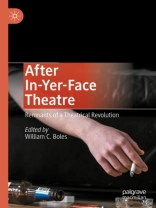This book revisits In-Yer-Face theatre, an explosive, energetic theatrical movement from the 1990s that introduced the world to playwrights Sarah Kane, Martin Mc Donagh, Mark Ravenhill, Jez Butterworth, and many others. Split into three sections the book re-examines the era, considers the movement’s influence on international theatre, and considers its lasting effects on contemporary British theatre. The first section offers new readings on works from that time period (Antony Neilson and Mark Ravenhill) as well as challenges myths created by the Royal Court Theatre about the its involvement with In-Yer-Face theatre. The second section discusses the influence of In-Yer-Face on Portuguese, Russian and Australian theater, while the final section discusses the legacy of In-Yer-Face writers as well as their influences on more recent playwrights, including chapters on Philip Ridley, Sarah Kane, Joe Penhall, Martin Crimp, Dennis Kelly, and Verbatim Drama.
Tabla de materias
1. Chapter One: Introduction: Reflections on In-Yer-Face from the Other Side of the Atlantic; William C. Boles.- 2. Chapter Two: “In the Pursuit of New Writers”: The Royal Court Young Peoples’ Theatre and the Development of First Time Playwrights in the 1990s; Nicholas Holden.- 3. Chapter Three: “A Shop Window for Outrage”: Harold Pinter’s
Ashes to Ashes, In-Yer-Face Theatre and the Royal Court’s 1996 West End Season; Graham Saunders.- 4. Chapter Four: “The Last Rolo”: Love, Conflict and War in Anthony Neilson’s
Penetrator; Rachael Newberry.- 5. Chapter Five: Mark Ravenhill’s Dialectical Emotions: “In-Yer-Face” as Post-Brechtian Theater; Anja Hartl.- 6. Chapter Six: Undressing Sarah Kane: A Portuguese Perspective on In-Yer-Face; Cátia Faísco.- 7. Chapter Seven: Russian “In-Yer-Face Theatre” as a Problem or a Process; Elena Dotsenko.- 8. Chapter Eight: Surfing the Wave of In-Yer-Face Theatre on Australian Shores; Sandra Gattenhof.- 9. Chapter Nine: The Hidden Dialogue between Sarah Kane and Edward Bond: The Dramaturgy of Accident Time and Ethical Subjectivities; Chien-Cheng Chen.- 10. Chapter Ten: From “In-Yer-Face” to “In-Yer-Head”: Staging the Mind in Martin Crimp, Sarah Kane and Anthony Neilson; Solange Ayache.- 11. Chapter Eleven: Philip Ridley: Still In-Yer-Face; Thomas A. Oldham.- 12. Chapter Twelve: Tales from the East End: Dialogic and Confessional Storytelling as Therapy (?) in the Plays of Philip Ridley; Cath Badham.- 13. Chapter Thirteen: Joe Penhall’s Fatherhood Plays: Escaping the Influence of Sam Shepard and the Lad; William C. Boles.- 14. Chapter Fourteen: “Experiential, not speculative”: Love In and After In-Yer-Face; Korbinian Stöckl.- 15. Chapter Fifteen: The Echo Chamber: Theater in a “Post-Truth” World.
Sobre el autor
William C. Boles holds the Hugh F. and Jeannette G. Mc Kean Chair of English at Rollins College. His previous books are The Argumentative Theatre of Joe Penhall and Understanding David Henry Hwang. He currently serves as the Director of the Comparative Drama Conference.












